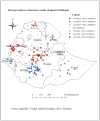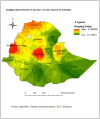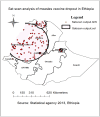Spatial distribution and determinants of measles vaccination dropout among under-five children in Ethiopia: A spatial and multilevel analysis of 2019 Ethiopian demographic and health survey
- PMID: 38976660
- PMCID: PMC11230542
- DOI: 10.1371/journal.pone.0305393
Spatial distribution and determinants of measles vaccination dropout among under-five children in Ethiopia: A spatial and multilevel analysis of 2019 Ethiopian demographic and health survey
Abstract
Background: Each year, vaccine-preventable diseases cost the lives of 8.8 million under-five children. Although vaccination prevents 1-2 million childhood deaths worldwide, measles vaccination dropouts are not well studied in developing countries, particularly in Ethiopia. Therefore, this study aims to assess the spatial distribution of the measles vaccination dropout and its determinants among under-five children in Ethiopia.
Methods: Data from Ethiopian Demographic and Health Survey 2019 was used for data analysis. The study used a total of 5,753 children. Spatial autocorrelations was used to determine the spatial dependency of measles vaccination dropout. Ordinary interpolation was employed to forecast measles vaccination dropout. Factors associated with measles vaccination dropout were declared significant at p-values <0.05. The data were interpreted using the confidence interval and adjusted odds ratio. A model with the lowest deviance and highest logliklihood ratio was selected as the best-fit model.
Results: In Ethiopia, one in three under-five children had measles vaccination dropouts. Factors such as birth interval (AOR = 1.87, 95% CI: 1.30, 2.70), unmarried marital status women (AOR = 3.98, 95% CI: 1.08, 8.45), ≤1 number of under-five children (AOR = 3.86, 95% CI: 2.56, 5.81), rural place of residence (AOR = 2.43, 95% CI: 2.29, 3.11), low community-level ANC utilization (AOR = 3.20, 95% CI: 2.53, 3.56), and residing in Benishangul Gumuz (AOR = 1.80, 95% CI: 1.061, 3.06) had higher odds of measles vaccination dropout.
Conclusions: Measles vaccination dropout rates in Ethiopia among under-five children were high compared to the maximum tolerable vaccination dropout level of 10% by the WHO. Both individual and community-level variables were determinants of measles vaccination dropout. The ministry of health in Ethiopia should give attention to those mothers of under-five children who reported underutilization of ANC services and rural residences while designing policies and strategies in areas of high spatial clustering of vaccine dropout in Ethiopia.
Copyright: © 2024 Zegeye et al. This is an open access article distributed under the terms of the Creative Commons Attribution License, which permits unrestricted use, distribution, and reproduction in any medium, provided the original author and source are credited.
Conflict of interest statement
The authors have declared that no competing interests exist.
Figures







Similar articles
-
Further analysis of determinants of Pentavalent and Measles immunizations dropouts among children under five years of age in Ethiopia from Mini-EDHS 2019.BMC Health Serv Res. 2024 Dec 2;24(1):1527. doi: 10.1186/s12913-024-11573-0. BMC Health Serv Res. 2024. PMID: 39623379 Free PMC article.
-
Geographical variation and associated factors of childhood measles vaccination in Ethiopia: a spatial and multilevel analysis.BMC Public Health. 2019 Aug 30;19(1):1194. doi: 10.1186/s12889-019-7529-z. BMC Public Health. 2019. PMID: 31470822 Free PMC article.
-
Individual and community-level determinants of pentavalent vaccination dropouts among under-five children in the sub-Saharan African countries: A multilevel analysis of the recent demographic and health survey.Vaccine X. 2024 Feb 22;17:100465. doi: 10.1016/j.jvacx.2024.100465. eCollection 2024 Mar. Vaccine X. 2024. PMID: 38435980 Free PMC article.
-
Applied nutritional investigation spatial variation and determinants of stunting among children aged less than 5 y in Ethiopia: A spatial and multilevel analysis of Ethiopian Demographic and Health Survey 2019.Nutrition. 2022 Nov-Dec;103-104:111786. doi: 10.1016/j.nut.2022.111786. Epub 2022 Jul 1. Nutrition. 2022. PMID: 35970098 Review.
-
Patterns of basic pneumococcal conjugated vaccine coverage in Ethiopia from 2015 to 2018; further analysis of Ethiopian DHS (2016-2019).Vaccine X. 2024 Jan 6;17:100428. doi: 10.1016/j.jvacx.2024.100428. eCollection 2024 Mar. Vaccine X. 2024. PMID: 38299201 Free PMC article. Review.
References
-
- Ethiopian Health and Nutrition Research Institute Federal Democratic Republic of Ethiopia. Guideline on Measles Surveillance and Outbreak Management, 3rd Edition. January 2012.
-
- Akalu HB. Review on measles situation in Ethiopia. Past and present J Trop Dis. 2015;4:193.
-
- Organization WH. United Nations Children Fund (UNICEF). Immunization. UNICEF data: monitoring the situation of children and women. 2020. 2020.
-
- World Health Organization. Immunization coverage. Fact sheets; 2020.
-
- IMMUNIZATION AGENDA—World Health Organization (WHO). 2030.
MeSH terms
Substances
LinkOut - more resources
Full Text Sources
Medical

